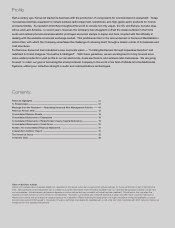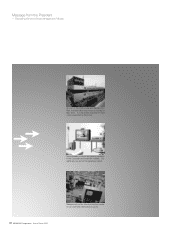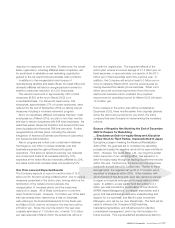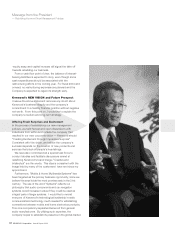Kenwood 2002 Annual Report Download - page 7
Download and view the complete annual report
Please find page 7 of the 2002 Kenwood annual report below. You can navigate through the pages in the report by either clicking on the pages listed below, or by using the keyword search tool below to find specific information within the annual report.
KENWOOD Corporation Annual Report 2002 05
Revitalization Action Plan. At its core, the plan consists of:
(1) The reform of business structure; and
(2) Augmentation of the cost structure.
The most critical issue in reforming business structure is
the reconstruction of the home electronics business to
secure its profitability and independence. In recent years,
low-priced products have dominated the global home audio
industry and a "commoditization" of audio products has
ensued. These trends had driven Kenwood to shift its
product policy toward low end products and expand its
production. This strategy turned out to be the major
contributor to the Company's unprofitable position.
Therefore, the turnaround plan will focus on a shift to a
value-added product portfolio consistent with the
longstanding quality brand image associated with Kenwood,
and on drastic measures to reduce costs and reorganize the
business in a shift "from quantity to quality." In the
domestic market, Kenwood will withdraw from the low-end
market and introduce home-theater systems, which have
already gained popularity in America. Overseas, we will
withdraw from the Asian market and the mini-component
systems market, while initiating an all-out effort to promote
high-end products, such as home-theater systems, in
America and Europe.
Costs will be cut by halving selling expenses and by
reducing production costs. Selling expense reduction will
come from the consolidation of the seven European sales
companies into three, the streamlining of American sales
offices, the reduction of domestic sales offices by half, and
the introduction of the sales representative system.
Savings in production are planned through more effective
production controls and a 50% workforce reduction at the
three current manufacturing plants, as production shifts to
the Malaysian plant.
Through these activities, the home electronics business
will yield profits and regain its autonomy, even though its
sales amount is expected to shrink by half, by year-end
March 2004.
The Personal Digital Cellular phone business, on the other
hand, is becoming increasingly risky as the product life cycle
is getting shorter and the software development cost is
increasing. Kenwood's business relationship with only one
telecommunication company led the Company to lose its
entire business for the latter half of fiscal 2003, when its new
model proposal was turned down. Under these
circumstances, we have decided to terminate the cellular
phone business as of November 2002 and relocate
engineers to more promising business fields.
In other non-profitable business areas, the PHS (Personal
Handyphone System) business has been terminated in
March 2002, and the production of home telephones ended
in August 2002. In addition, two affiliated companies —
Kenwood Precision and Kenwood ID, that have been
manufacturing optical devices and wireless ID cards
respectively, have been liquidated. In a similar move,
Kenwood TMI, which has been marketing measuring
instruments, was sold to Nipponkeori Kaisha, LTD in
May 2002.
Solidifying the Cost Structure for Increased
Profitability
Next, I would like to explain our cost containment initiatives
— another point in the action plan.
First, we will lower production costs by reorganizing our
manufacturing network. Currently, production takes place at
nine different locations in and out of Japan. Our plan calls
for consolidating manufacturing to six locations after closing
three plants in Mexico, Hungary, and Huizhou City, China. At
the same time, plants in Yamagata, France, and Singapore
will be streamlined to enable a total manpower reduction of
1,900 employees (42%) engaged in manufacturing activities
throughout the world.
With this measure, Kenwood's car electronics production,
which currently takes place in Nagano, Mexico, Hungary,
and Malaysia, will be consolidated to three plants in Nagano,
Shanghai, and Malaysia. Likewise, the home electronics
production, which is taking place in Huizhou, Shanghai, and
Malaysia, will be consolidated to one plant in Malaysia.
Wireless radio products, currently produced in Yamagata
and Singapore, will move production to Yamagata and
Bintang Island, Indonesia.
We will also rationalize our sales network to capture
significant savings in marketing expenses. Kenwood will
shift its overseas sales activities to the car electronics and
wireless radio products, while the sale of home electronics
products will be limited to America and three major markets
in Europe. Domestically, the number of sales offices for
home electronics will be also reduced by half, with a




















